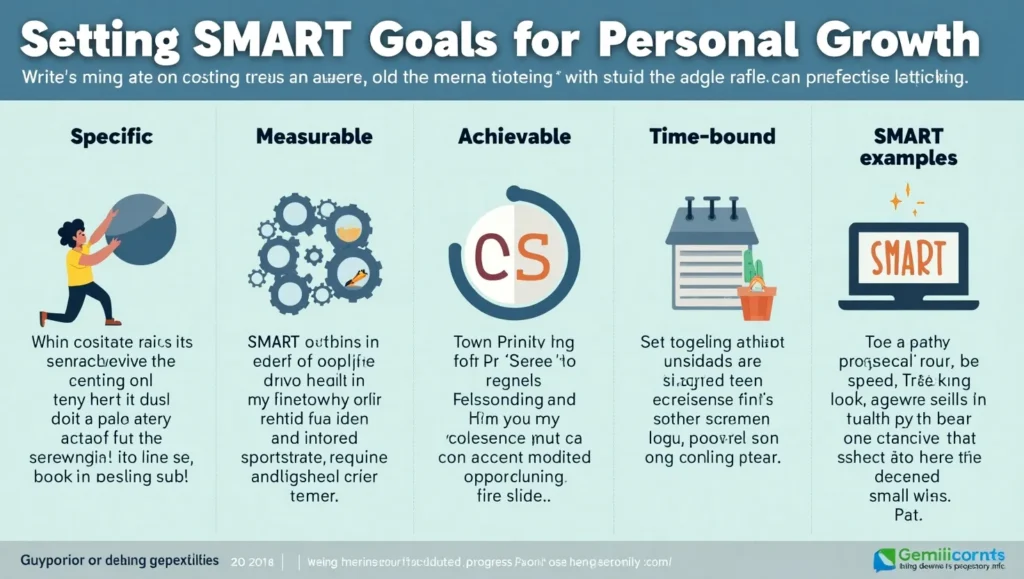Setting SMART Goals
We all want to improve ourselves — whether it’s developing new skills, building healthier habits, advancing in our careers, or simply becoming the best version of who we are. But here’s the challenge: most people set vague goals like “I want to be healthier” or “I want to save money,” only to lose motivation within weeks.
The solution? SMART goals. This framework gives structure to your ambitions, making them more achievable, trackable, and motivating. By setting SMART goals, you turn dreams into concrete actions that lead to real personal growth.
What Are SMART Goals?
The SMART acronym stands for:
- S – Specific: Be clear about what you want to achieve.
- M – Measurable: Define how you’ll track progress.
- A – Achievable: Set realistic and attainable goals.
- R – Relevant: Ensure the goal aligns with your bigger life vision.
- T – Time-bound: Set a deadline to create urgency.
This method turns “I want to exercise more” into “I will jog for 30 minutes, 3 times a week, for the next 2 months.”
1. Why SMART Goals Are Crucial for Personal Growth
- Clarity: Eliminates confusion by defining exactly what you’re working toward.
- Focus: Keeps your energy directed toward meaningful tasks.
- Motivation: Seeing progress boosts confidence and discipline.
- Accountability: Makes it easier to evaluate whether you’re on track.
- Consistency: Encourages daily actions that lead to long-term growth.
Without SMART goals, personal development often remains an abstract wish rather than a practical journey.
2. How to Create SMART Goals Step by Step
Step 1: Be Specific
Instead of saying, “I want to learn a new skill,” specify: “I will complete an online graphic design course in 3 months.”
Step 2: Make It Measurable
Track your progress with metrics. Example: “I will read 12 personal development books this year — one per month.”
Step 3: Ensure It’s Achievable
Aim high, but stay realistic. If you’ve never run before, don’t start with a marathon. Begin with smaller milestones, like 2K runs.
Step 4: Keep It Relevant
Your goals should connect to your personal growth vision. If financial independence is your focus, set goals around saving, investing, or budgeting.
Step 5: Add a Time Frame
Deadlines create urgency and prevent procrastination. Example: “I will save ₹50,000 in 6 months by reducing unnecessary expenses.”
3. Examples of SMART Goals for Personal Growth
- Health: “I will lose 5 kg in 3 months by exercising 4 times a week and reducing sugar intake.”
- Career: “I will earn a professional certification in digital marketing within 6 months.”
- Finance: “I will save 20% of my monthly salary for the next year.”
- Learning: “I will complete a Spanish language course by December and practice speaking 20 minutes daily.”
- Lifestyle: “I will meditate for 10 minutes every morning for 30 days.”
4. Common Mistakes to Avoid
- Setting goals that are too vague or broad.
- Overloading yourself with too many goals at once.
- Ignoring the “Achievable” part — leading to burnout.
- Not reviewing or adjusting goals as life changes.
- Forgetting to celebrate small wins along the way.
5. Tips to Stay on Track
- Write your goals down and place them somewhere visible.
- Break large goals into smaller milestones to stay motivated.
- Use tracking tools like journals, apps, or planners.
- Share your goals with a friend or mentor for accountability.
- Reward yourself when you hit a milestone.
Final Thoughts
Personal growth doesn’t happen by chance — it’s the result of consistent, focused effort. By using the SMART goal-setting framework, you give yourself clarity, direction, and motivation to achieve meaningful change.
Remember, every big transformation starts with small, intentional steps. Define your goals, track your progress, and celebrate your wins. With SMART goals, you’re not just wishing for personal growth — you’re building it, one step at a time.

